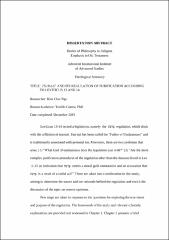| dc.contributor.author | Ngo, Kim Chai | |
| dc.date.accessioned | 2023-03-08T02:34:50Z | |
| dc.date.available | 2023-03-08T02:34:50Z | |
| dc.date.issued | 2019-12 | |
| dc.identifier.uri | https://dspace.aiias.edu/xmlui/handle/3442/483 | |
| dc.description | Unpublished Dissertation (PhD Religion)
Shelf Location: BS1255.52 .N46 2019 | en_US |
| dc.description.abstract | Leviticus 13-14 record a legislation, namely, the צָרַעַת regulation, which deals with the affliction of tsaraat. Tsaraat has been called the “Father of Uncleanness” and is traditionally associated with personal sin. Moreover, there are two problems that arise. (1) “What kind of uncleanness does the regulation deal with?” (2) “Are the more complex purification procedures of the regulation other than the diseases listed in Lev 11-15 an indication that צָרַעַת carries a moral guilt connotation and an accusation that
צָרַעַת is a result of a sinful act?” These are taken into consideration in this study, aiming to determine the nature and the rationale behind the regulation and enrich the discussion of the topic on current opinions.
Few steps are taken in response to the questions for exploring the true intent and purpose of the regulation. The framework of the study and relevant scholarly explanations are provided and reviewed in Chapter 1. Chapter 2 presents a brief
examination of the cases of צָרַעַת in the ANE texts and in non-Levitical narratives to grasp the significant connection between those documents with the Levitical צָרַעַת . The exegetical analysis of the regulation of צָרַעַת in Chapter 3 expresses the literary analysis of the regulation and the contextual meaning of several words which are considered traditional sin-related terms. However, נגֶַ֣ע צָרָָ֑עַת denotes a generic name for various skin diseases in the regulation, which can be cleaned and are not associated with sin; the sacrificial offerings חַטָאת and אָשָם can be purificatory in the ceremonial ritual that functions to cleanse or to wipe off uncleanness. At the same time, the intention and motif to remove the uncleanness of the צָרַעַת are attested to by each step of the purification ritual. Based on the close study of the relation between sin and disease in the context of Lev 13 and 14, chap. 4 reveals that צָרַעַת is a disease like the other diseases in the OT. It lies not only among the sick but also in their social environments and in the larger universe. צָרַעַת makes people ceremonially unclean; consequently, it causes alienation from God and fellow humans. As a result, God establishes a cleansing procedure so that those who are cleansed are reinstated and can come near and approach Him. The complex decontamination procedures are simply steps to remove the uncleanness and can only be accomplished by God alone who knows the solution of this design to provide a complete procedure. Through the צָרַעַת regulation, the interplay of God’s holiness, ceremonial cleanliness, and didactic nature are revealed. Lastly, the summary of the research findings, conclusions, and recommendations are given in Chapter 5. | en_US |
| dc.language.iso | en_US | en_US |
| dc.publisher | Adventist International Institute of Advanced Studies | en_US |
| dc.subject | Judaism -- Customs and practices. | en_US |
| dc.subject | Bible. -- Leviticus -- Criticism, interpretation, etc. | en_US |
| dc.subject | Bible. -- Leviticus, XIII-XIV -- Criticism, interpretation, etc. | en_US |
| dc.title | Tsaraat and its regulation of purification according to Leviticus 13 and 14 | en_US |
| dc.type | Dissertation | en_US |

